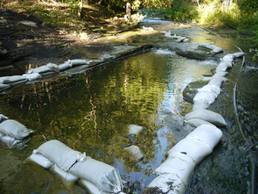Bass Lake Creek

Spawning Habitat Enhancement Project
The 2010 Bass Lake Creek spawning habitat enhancement project site is traditionally a very active spawning area specifically for Walleye, Salmon and Trout. Due to fluctuating water levels coming out of Bass Lake the area in which the fish would spawn would be underwater during the spawning period, but the level of water would drop and leave this valuable and popular spawning area dry, causing a high mortality rate in the spawned eggs.
In order to rehabilitate or enhance this site, a plan was created to chisel and excavate a 5m x 7m (approx. 16’ x 24’) area of shale Lindsay formation to a depth of 1.3 metres below its current level and fill the bottom 30 cm with spawning gravel. The total surface area of enhanced productive spawning area produced was 35m2. The project brought the river bed in this area flush with the rest of the river bed, which allowed this popular spawning area to be underwater year round. Also, conducted at this site was bank stabilization where another 7m x 4m or 28m2 was repaired, graded and planted with Right of Way mixture grass seed.
Funding contributions toward the construction of the project include CFWIP, COA and NOHFC.
This project had 3 volunteers from the Little Current Fish and Game Club, 2 volunteers worked a combined 10 hours on preparation work at the site consisting mostly of delivery and washing of spawning gravel. The landowner provided 18.5 hours of site supervision and preliminary site visits with contractors for the project.
This project also had 7 volunteers from the Board of Directors of Manitoulin Streams participate in planning and actively volunteering at rehabilitation sites. The total number of hours volunteered for this site is 51.4 hours.
The 2010 Bass Lake Creek spawning habitat enhancement project site is traditionally a very active spawning area specifically for Walleye, Salmon and Trout. Due to fluctuating water levels coming out of Bass Lake the area in which the fish would spawn would be underwater during the spawning period, but the level of water would drop and leave this valuable and popular spawning area dry, causing a high mortality rate in the spawned eggs.
In order to rehabilitate or enhance this site, a plan was created to chisel and excavate a 5m x 7m (approx. 16’ x 24’) area of shale Lindsay formation to a depth of 1.3 metres below its current level and fill the bottom 30 cm with spawning gravel. The total surface area of enhanced productive spawning area produced was 35m2. The project brought the river bed in this area flush with the rest of the river bed, which allowed this popular spawning area to be underwater year round. Also, conducted at this site was bank stabilization where another 7m x 4m or 28m2 was repaired, graded and planted with Right of Way mixture grass seed.
Funding contributions toward the construction of the project include CFWIP, COA and NOHFC.
This project had 3 volunteers from the Little Current Fish and Game Club, 2 volunteers worked a combined 10 hours on preparation work at the site consisting mostly of delivery and washing of spawning gravel. The landowner provided 18.5 hours of site supervision and preliminary site visits with contractors for the project.
This project also had 7 volunteers from the Board of Directors of Manitoulin Streams participate in planning and actively volunteering at rehabilitation sites. The total number of hours volunteered for this site is 51.4 hours.

